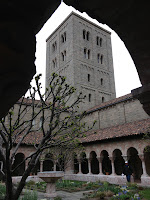It is located in Fort Tryon Park (260 hectares), Washington Heights, and contains one of the world’s most important collections of Medieval European Art with over 5,000 works from the 12th– 15th centuries. The extensive surrounding gardens are planted according to medieval horticultural manuscripts of the time and focus on trees, plants and herbs which were prized as much for their medicinal qualities as for their beauty and form.
The Cloisters location, on top of a hill at the centre of a park that overlooks the Hudson River, is idyllic and, in order to preserve the magnificent views, ‘Junior’ bought up several hundred acres of the towering cliffs of the NJ Palisades directly across the river and kept them preserved as natural bush parkland. As a result of his munificence today one can still look out from the Cloisters not only to the park but across the river to an amazingly beautiful natural landscape.
The actual ‘Cloisters’ building is an amalgamation of bits of five French cloistered abbeys that were purchased by Junior after WW1, disassembled and shipped back, brick by brick and stone by stone to the US where they were re-assembled from 1934 – 1938. The core of the works in the collection that it houses was originally assembled by the American artist and sculptor George Grey Barnard.
When Barnard passed away ‘Junior’ purchased his collection, which had previously been on display in another location and combined it with his own collection, which most notably included the ‘Hunt of Unicorn’ series of tapestries, Robert Champin’s Merode Altarpiece and the Romanesque altar cross known as the ‘Cloister’s Cross’ or the ‘Bury St Edmund’s Cross’.
This last piece is amongst the oldest in the entire collection (it dates from the middle of the thirteenth century) and is simply spectacular in its design and the craftsmanship of its execution.
It is carved from walrus ivory, which is extremely difficult to carve, but elephant tusk ivory was unknown in England in the 13th century so the maker of the cross really had no alternative. The cross is not large, it measures just 57.5 × 36.2 cm but the carvings which cover both front and back sides of the cross are masterful. The carvings include ninety-two intricately detailed figures and ninety-eight inscriptions.
The figures, each of which is only about one-half inch tall, illustrate a number of Biblical scenes, and on the back, a number of the Old Testament prophets with banderoles containing quotations from their books. The sculptor is not known although Thomas Hoving, who managed the acquisition of the cross while he was Associate Curator at the Cloisters, concluded that it was carved by Master Hugo at the Bury St. Edmunds Abbey in Suffolk.
The $2.50 bus ride home to the corner of Fifth Avenue and East 72nd Street was fascinating and totally worth the 1.5 hours it took. The action inside and outside the bus as we travelled downtown through ‘Harlem’ was something we had not seen before. Most amusing sight was a shopfront for a combined ‘Lawyer and Taxi Service’.








No comments:
Post a Comment